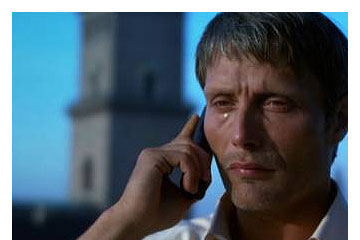So when you go to the movies, which of the following do you want: A) a shotgun-wielding hobo or B) a bunch of semicoherent 20-somethings muddling through relationships? Pick an answer and stick to it.
I jest, but then again I do not. There are lots of reasons why it’s great to attend South by Southwest shortly after Sundance, even beyond the better weather and better food. This festival produces a kind of long-term, deep-focus forecast of filmmaking themes and trends that aren’t quite yet on the mainstream radar screen, while Sundance provides a chance to marinate in a complex brew of right-now hipness, just before it ferments.
It’s simplistic to say that the narrative features in SXSW this year fall into either the shotgun-hobo camp or the youthful plotless mumbling camp. But it’s not exactly wrong. This represents a larger division — between, you might say, art-film masochists and genre-film geeks — that has long existed among directors, critics and movie buffs. For some reason I haven’t quite divined, the film aesthetic of this city and this festival right now demonstrates this clash in its purest form.
On Sunday morning I saw Austin heroes Robert Rodriguez and Harry Knowles give an award to the local guy who made “Hobo With a Shotgun,” or, anyway, who might make it. You see, “Hobo With a Shotgun” doesn’t actually exist. It’s a three-minute trailer, full of fake scratches and stains, advertising an imaginary ’70s-style film about an odoriferous, streetwise Robin Hood who seeks vengeance against corrupt authorities.
Full of explosive gore and wacky sight gags, “Hobo” was the winner of Rodriguez’s “grindhouse trailer” competition, which featured such equally nonexistent runners-up as “The Dead Won’t Die” (a pseudo-feminist revenge fantasy, with zombies) and “Maiden of Death,” featuring a guitar-wielding and frequently naked female gunslinger. Based on this minisurvey of the grindhouse tradition, the key ingredients are grotesque splatter, bare breasts and elaborate fantasies of victimization and revenge.
Later that night, I was jammed into the balcony of downtown Austin’s historic Paramount Theater for the celebratory premiere of “Hannah Takes the Stairs,” a new film from DIY-style Chicago director Joe Swanberg, whose career is closely tied to this festival. There’s no shortage of nudity (both male and female) in “Hannah,” but that might be the lone point of connection between the Swanbergian aesthetic and grindhouse.
“Hannah Takes the Stairs” is a collaborative, entirely improvised ensemble picture, personally shot by Swanberg with a hand-held video camera and a crew of one. It’s episodic and virtually plotless, following the eponymous Hannah (Greta Gerwig) as she dumps her burnout musician boyfriend for an overachieving co-worker and then for another, more grounded one, with whom she can play a cacophonous trumpet-duet version of the “1812 Overture.” In the bathtub. That’s really about it.
Most of the Paramount audience responded warmly to “Hannah” for its moments of sharp perception and its stringent, comic-wistful realism. Intriguingly, there were quite a few walkouts from my section, possibly more than the violence of a movie like “Hobo With a Shotgun” would occasion. An entire row of Austin women in front of me got up to leave about half an hour in, and I almost ran after them to hear their reasons.
In fact, their reaction was no mystery, although I didn’t precisely share it. I admire Swanberg’s ambition and integrity immensely, and the intimate moments he captures are a direct result of his unusual method. I like the ideas behind his work, and I’m grateful that he’s making it. But the ultra-low production values in “Hannah” (the sound is tinny and sometimes almost inaudible) and nearly total lack of narrative intensity make for a highly uneven viewing experience. I love movies in the tradition that he’s clearly referencing, movies by Bergman or Cassavetes or Jarmusch that are more like life experiences than straightforward narratives. In fact, he might want to draw on them more heavily; I suspect Swanberg’s work would benefit from more domineering, artistic-dictator behavior on his part, rather than less.
Swanberg is a key figure in what seems to be a nascent movement on the fringes of American cinema, combining a severe and often unscripted naturalism (as here) with an indie-rock ethic of self-help, self-distribution (as necessary) and community building. His cast largely consists of other filmmakers, many of whom he met at SXSW in previous visits. The overachieving co-worker, for example, is played by Andrew Bujalski, director of the near-underground cult hits “Mutual Appreciation” and “Funny Ha Ha,” and probably the founding figure of this movement. (All such statements will piss somebody off, and I preemptively apologize.)
Hannah’s dumped boyfriend is played by Mark Duplass, who made the fine 2006 micro-indie “The Puffy Chair” with his brother Jay, and Hannah’s overly passive roommate is played by Ry Russo-Young, whose directorial debut, “Orphans,” premieres here on Monday night. (Kent Osborne, who plays the bathtub-trumpet final boyfriend, has also written, produced and directed both film and TV productions.)
What we’ve got here, I guess, is the age-old division between ideologically loaded, and semi-opposing, sets of aesthetic terminology: plot vs. characters, form vs. content, artifice vs. realism, art vs. entertainment. Of course the right answer to this dilemma is to go all Solomonic and proclaim that there is no right answer. Bujalski’s films, for instance, have a curiously fatalistic forward momentum, for all their plotlessness. And a great grindhouse director can make us feel the passionate humanity beneath that firearm-wielding hobo’s bloody quest for homemade justice.
Consider the marriage of ingredients in Grace Lee’s “American Zombie,” which is also here (and which I already reviewed at Slamdance). It’s a personal, talky, funny and intimate film about human relationships. Human relationships with zombies. Therein, ladies and gentlemen, living and undead, lies the future of independent cinema.

